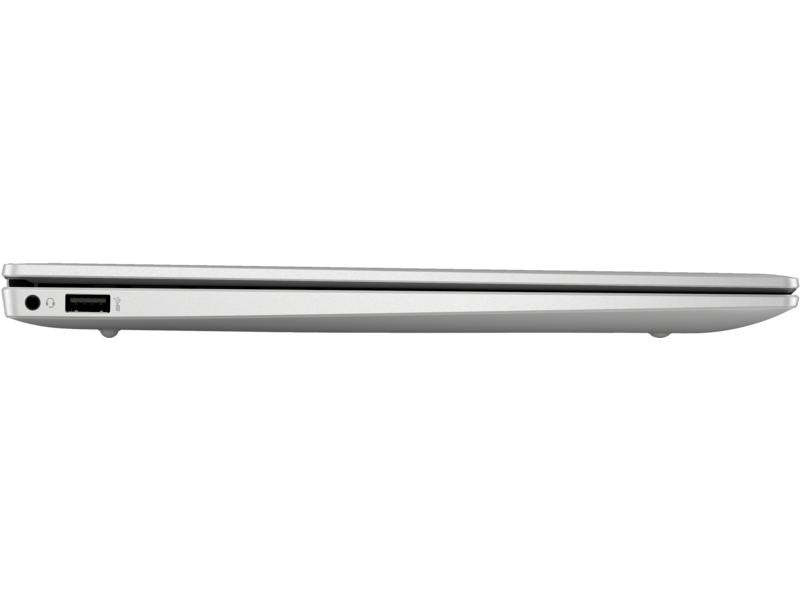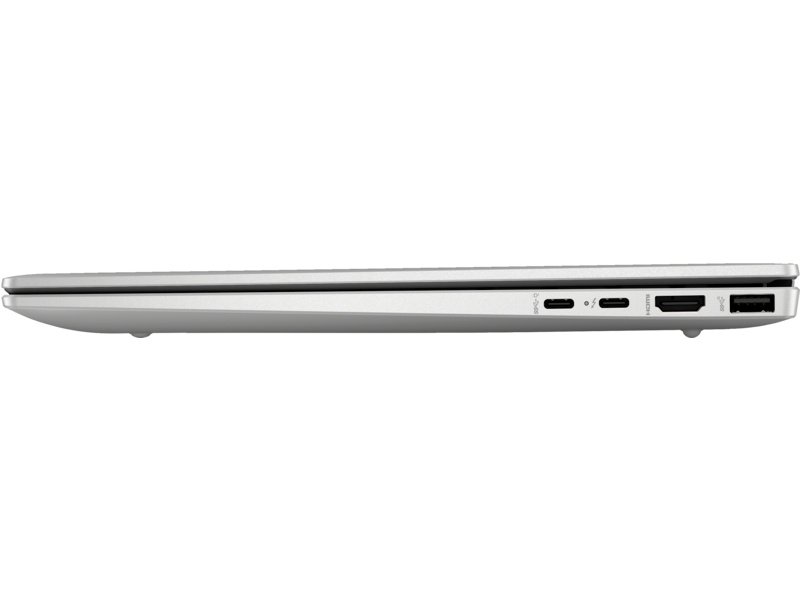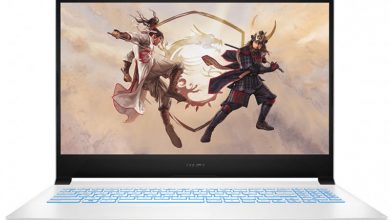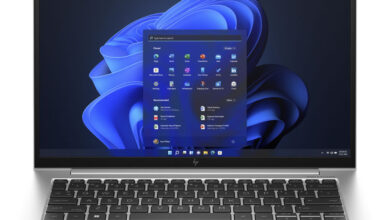HP, considered one of the top computer brands in its niche, has different notebook lineups, catering to the needs of every kind of notebook user. If you are a gamer, HP has the Omen and Victus series for you. If you are looking for a business segment notebook with slim profiles, HP has the Pavilion, Elite, ProBook lineup, and many more.
The notebook we got in-house for today’s review belongs to HP’s famous Pavilion series and is named HP Pavilion Plus 14 2024. The HP Pavilion series is renowned for its balance of affordability, performance, and sleek design. Offering versatile configurations, customization options, and reliable hardware, Pavilion laptops, and desktops cater to everyday computing needs without breaking the bank, making them popular among consumers seeking stylish yet functional devices.
It is worth mentioning that HP has updated its 2024 models of the Pavilion series with the Intel Core Ultra series CPUs. The model we are reviewing is powered by the Intel Core Ultra 7-155H CPU, integrated with Intel Arc GPU. In addition, it has everything like LPDDR5x RAM, PCIe 4.0 SSD support, and a high-resolution display, all of which are discussed in the specifications table.
HP Pavilion Plus 14: Specifications
| Screen | 14-inch, 2.8K (2880 x 1800), 16:10 golden ratio, OLED, 48 – 120 Hz VRR variable refresh rate, ultra-narrow bezels, low blue light, 500 nits HDR peak brightness, 100% DCI-P3 cinematic Color gamut, DC-like dimming |
| Processor | 1st Generation Intel Core Ultra 7-155H (up to 4.8 GHz with Intel Turbo Boost Technology, 24 MB L3 cache, 16 cores, 22 threads) |
| Wireless Connection | Intel Wi-Fi 6E AX211 (2×2) and Bluetooth 5.3 wireless card |
| Graphics card | Integrated Intel Arc GPU |
| Memory | 32 GB LPDDR5x-7467 MHz dual-channel memory (onboard, 2*16GB modules) |
| Storage | 1TB PCIe 4.0 NVMe M.2 SSD (Samsung PM9B1) |
| Ports |
1x USB Type-A port at 5Gbps transfer rate 1x USB Type-A port at 10Gbps transfer rate 1x Thunderbolt 4 port with USB Type-C port at 40Gbps transfer rate (USB Power Delivery, DisplayPort 1.4 port, HP Sleep and Charge Port) 1x full-featured USB Type-C port, 10Gbps transfer rate 1x HDMI 2.1 (TMDS) port 1x headphone/microphone combo jack |
| Battery | 4-cell 68WHr Lithium-ion Polymer battery with 100W AC Type-C Adaptor |
| OS | Windows 11 Home Edition |
| Weight | 3.17lb (1.44kg) |
HP Pavilion Plus 14: Body Design and Appearance
The all-new 2024 HP Pavilion Plus 14 model comes in three color options: Silver, Pink, and Blue. The one we are reviewing is in a natural silver aluminum color. The entire body is made of aluminum, and the surface is frosted to maintain the Pavilion series’ aesthetics. We have the new generation HP logo on the display shell, which is just some lines that make “HP.”
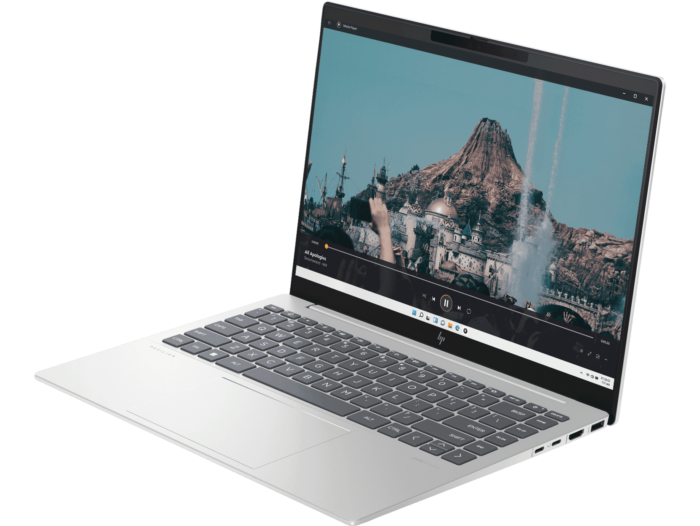
Regarding technical specifications, the notebook has the following dimensions: 314x227x17.5 mm and weighs 1.44kg. The weight and dimensions are acceptable. However, carrying the notebook feels lightweight due to proper weight distribution and provides a premium feel, thanks to the frosted aluminum surface.
It is also worth noting that the notebook supports only a 145-degree opening and has also passed the MIL-STD-810H military standard tests, which include drop test, temperature test, humidity test, and different kinds of durability tests, which denotes that the build quality of the notebook is going to be awesome.
HP Pavilion Plus 14: Display
On unfolding the notebook, you will find a 14-inch OLED Display that comes with a 16:10 aspect ratio and supports 2.8K resolution (2880×1800) with 48-120Hz VRR (variable refresh rate). The advantage of VRR technology in the display is that it adjusts the refresh rate according to the scenario, which helps reduce the notebook’s battery consumption. The screen-to-body ratio is 88%, which could have been higher if the space on the top border was eliminated.
In addition to this, the display also supports 500nits peak brightness in HDR mode, DC dimming, 10-bit color depth, and 0.2ms response. The officials also claimed that the display supports 100% DCI-P3 color gamut and passed the TÜV Rheinland hardware-level low blue light certification and SGS Eye Care eye protection certification. Watching the screen is less harmful to the eyes and is more suitable for users who need to work in front of the notebook’s screen for a long time.

In the upper screen frame, the notebook features a 5MP camera sensor (HP Wide Vision 5MP IR Camera) as a webcam that supports facial recognition (Windows Hello unlock). Above the camera, we have a physical shutter that allows you to block the camera view when not in use to ensure privacy.
To do the display benchmark testing, we used the classic Spyder X. This test found that this display covers 100% sRGB, 94.6% AdobeRGB, and 99.9 DCI-P3 color gamut. In terms of color accuracy, the average Delta-E value is 0.90 (1.88 highest and 0.29 lowest), which indicates that the display’s color accuracy is excellent. Through AIDA64, we also learned that the manufacturer of this display is Samsung, one of the top OLED display manufacturers.
HP Pavilion Plus 14 (Intel) Screen Test Results |
|
| sRGB | 100% |
| Adobe RGB | 94.6% |
| DCI-P3 | 99.9% |
| Maximum Brightness | 500nits |
| Average Delta E | 0.90 |
HP Pavilion Plus 14: Keyboard and TouchPad
Moving on from the display, let’s look closer at the keyboard. At first glance, there appears to be no visual difference, and indeed, it remains identical to the previous model in terms of appearance. The arrangement of keys is the same as in the old model. The power button is located in the upper right corner; the arrow key has the same layout, and the up and down arrow keys are half the size of the right and left keys. It is also worth mentioning that the keyboard’s key is soft-grey and supports white color backlit with three brightness levels. However, the keyboard lacks the NumericPad due to the smaller dimensions of the notebook.

Beneath the keyboard lies the generously sized “HP ImagePad,” HP’s designated touchpad, boasting support for multi-touch gestures, as confirmed by official sources. Its ample size ensures seamless cursor navigation across Windows interfaces. With a single long swipe, effortless navigation to any corner is achievable.
Also Read: MSI Crosshair 16 HX D14V Review
HP Pavilion Plus 14: Ports
Regarding port, the notebook is once again a pretty satisfactory option. In total, the manufacturer has provided six ports that can cater to all an office user’s basic needs. However, the previous model also has the same number of ports.
Starting from the left side, we have just two ports, including the 3.5mm headphone jack and a single USB Type-A (which supports 5Gbps transfer speed). On the right, we have another USB Type-A port (supports 10Gbps transfer rate), an HDMI 2.1 TDMS port, a USB Thunderbolt 4 Type-C port (supports 40Gbps transfer rate, USB PD and DisplayPort 1.4), and a USB Type-C 3.2 full-featured port (10Gbps transfer rate).
These ports can quickly meet the connectivity needs of daily office use. However, if you still think they are insufficient, you can buy an additional USB dock with Thunderbolt 4 support to enjoy faster file transfers.
HP Pavilion Plus 14: Battery and Charging
A battery is a preeminent thing that matters a lot in a business-segment notebook. In the case of this notebook, the HP Pavilion Plus 14 is equipped with a 4-cell 68WHr lithium-ion polymer battery that seems to have pretty good capacity with a 14-inch laptop. When it comes to upgrades, HP has opted to maintain the battery capacity, with the 2023 model featuring the same battery capacity as its predecessor.
According to official claims, the notebook can provide up to 13 hours of battery backup, as tested by MobileMark25 testing by officials. In addition, for charging, the officials have provided a 100W AC Type-C charger, which can charge 50% of the battery in just 30 minutes, as stated by the officials.
We used the PCMark 10 Modern Office benchmark app to test the battery on our own. Before starting the test, we disconnected all the external devices (like USB, headphones, and external mouse), adjusted the screen brightness to 50%, and turned the balance mode on, and the speaker and Wi-Fi were turned off. In these settings, we got a battery backup of 15 hours and 29 minutes, which is more than satisfactory. We can say that the user wouldn’t be required to carry the charger during office hours.
HP Pavilion Plus 14: RAM and SSD
After the CPU, RAM, and Storage are the major factors influencing the notebook’s speed. In terms of RAM, the HP Pavilion Plus 14 supports LPDDR5x RAM. It is worth mentioning that in some regions, the model that HP is shipping supports LPDDR5x RAM with 6400MHz frequency. However, the model we are reviewing comes with LPDDR5x-7467MHz RAM. This RAM is a Dual-Channel RAM with a capacity of 32GB. The RAM is soldered on the motherboard, so it cannot be upgraded.
We used the AIDA64 Cache and Memory Benchmark application to benchmark the RAM. On completion of the test, we found the following results: 86,251 MB/s Read Speed, 73,571 MB/s Write Speed, and 93,770 MB/s Copy Speed, while the latency rate was 138.2ns. Results suggest that the benchmark results are notably impressive, particularly regarding copying speed.
In terms of storage, the notebook supports only PCIe 4.0 SSD protocols. The model we are reviewing is equipped with a 1TB PCIe 4.0 NVMe SSD manufactured by Samsung. The SSD is the Samsung PM9B1, a mid-range SSD. To upgrade storage, you would be required to replace the current SSD because there is only one SSD slot.
For the benchmark test of SSD, we used the CrystalDiskMark application. On completion of the test, we got the following results: 3,639MB/s Sequential Read Speed, 2,901 MB/s Sequential Write Speed, 62.19 MB/s Random 4K Read Speed and 138.09 MB/s Random 4K Write Speed. The scores are pretty average.
HP Pavilion Plus 14: CPU and its Benchmarks
HP has recently updated its Pavilion 14 series with the Intel Core Ultra series. The notebook is available in both Intel Core Ultra 5 and Intel Core Ultra 7 CPU options. The model we are reviewing is powered by the Intel Core Ultra 7 CPU. The CPU uses Intel 4 Process Technology, which has 16 cores and 22 threads. These 16 cores include 6x P-Cores (1.4GHz Base Frequency and 4.8GHz Peak Frequency), 8x E-Cores (900MHz Base Frequency and 3.8GHz Peak Frequency), and 2x LP E-Cores (700MHz Base and 2.5GHz Peak Frequency). This 3D high-performance hybrid architecture can balance performance and energy consumption, bringing a better office creation experience.
In addition, the CPU also has a 24MB L3 Intel Smart Cache, and the default TDP is 45W. The CPU is also integrated with the Intel Arc-integrated GPU, discussed in the next section. The following are the CPU benchmark results.
CPU-Z: 748 on Single-Core and 7,924 on Multi-Core
Geekbench 6: 2,385 Single-Core Score and 13,066 Multi-Core Score
We also compared CPU-Z benchmark scores with scores of some competitor models.
| Laptop Model (Intel Core Ultra 7 Powered) | CPU-Z Single-Core | CPU-Z Multi-Core |
| Dell Inspiron 14 Plus 7440 (45W) | 682 | 7,398 |
| ASUS Zenbook 14 OLED (28W) | 697 | 7,128 |
| Lenovo ThinkPad X1 Carbon Gen12 (28W) | 675 | 6,884 |
| HP Pavilion Plus 14 2024 (45W) | 748 | 7,924 |
HP Pavilion Plus 14: Integrated GPU and its Benchmarks
With the all-new Core Ultra series CPUs, Intel has provided the next-generation Intel Arc Graphics. The Intel Arc GPU has dramatically improved compared to previous generations of integrated GPUs. It comprises 8 Xe Cores and has advanced functions and technologies like AI, Ray Tracing, and XeSS. Following are the benchmarks of GPU:
3DMark Fire Strike: 9,861 GPU Score
3DMark Fire Strike Extreme: 4,428 GPU Score
3DMark TimeSpy: 3,841 GPU Score
3DMark Port Royal: 1,679 GPU Score
HP Pavilion Plus 14: CPU Stress Testing
In the end, it is time for stress testing on the CPU. Let’s start with the heat dissipation system of this notebook. The notebook consists of a single fan and single heat pipe, which can be seen on the disassembly of the notebook. The heat ventilation system might feel weak, but let’s check how it would work.
For stress testing the CPU, we used the AIDA64 FPU Test. After 10 minutes of testing, the power consumption of the CPU reached 52W, and the temperature was at 88°C degree. In terms of core frequency, the P-Core frequency was at 3.1GHz while the E-Cores’ frequency was at 3.55GHz. The heat dissipation performance inside the HP Pavilion Plus 14 is entirely satisfactory.
Also Read: Lenovo IdeaPad Pro 5 14AHP9 Review
Summary:
The HP Pavilion Plus 14 2024 review highlights a refined addition to HP’s Pavilion series, emphasizing a blend of performance, aesthetics, and functionality. Powered by the Intel Core Ultra 7 CPU and featuring the Intel Arc GPU, this model promises robust performance suitable for business and everyday computing tasks.
Design-wise, the Pavilion Plus 14 boasts a sleek aluminum body in three color options and undergoes rigorous MIL-STD-810H testing for durability. Its 14-inch OLED display impresses with a 2.8K resolution, VRR technology, and various certifications for eye protection. It includes a 5MP IR camera with a privacy shutter, which enhances security and convenience. The keyboard and touchpad maintain familiarity and functionality, offering backlit keys and multi-touch gesture support. Connectivity options include a range of ports catering to office needs, although additional docking may be necessary for some uses.
Battery life is commendable, with up to 13 hours of backup and fast charging capabilities. The LPDDR5x RAM and PCIe 4.0 SSD contribute to speedy performance, supported by benchmark results showcasing impressive copying speeds and storage capabilities. The Intel Core Ultra 7 CPU, accompanied by Intel Arc GPU, delivers solid performance, as evidenced by benchmark scores. The notebook’s heat dissipation system ensures efficient cooling during intensive tasks, maintaining satisfactory temperature levels.
Overall, the HP Pavilion Plus 14 2024 excels in offering a balanced package of performance, design, and durability, making it a compelling choice for users seeking a reliable and stylish computing solution. At the moment, the variant of the notebook we have reviewed is priced at $899. If you are low on budget and can compromise a bit in performance, go for the Intel Core 5 Ultra CPU-powered variant with the same memory and storage, priced at $849.


